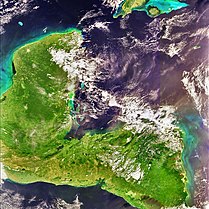
Back Federale Republiek van Sentraal-Amerika Afrikaans جمهورية أمريكا الوسطى الاتحادية Arabic República Federal d'América Central AST مرکزی فدرال آمریکا جومهوریتی AZB Злучаныя Правінцыі Цэнтральнай Амерыкі Byelorussian Федерална република Централна Америка Bulgarian Proviñsoù Unanet Kreizamerika Breton Províncies Unides de l'Amèrica Central Catalan Federativní republika Střední Ameriky Czech Gweriniaeth Ffederal Canolbarth America Welsh
Federal Republic of Central America República Federal de Centro América | |||||||||||||||||||
|---|---|---|---|---|---|---|---|---|---|---|---|---|---|---|---|---|---|---|---|
| 1823–1839/1841 | |||||||||||||||||||
| Motto: "Dios, Unión, Libertad" "God, Union, Liberty" | |||||||||||||||||||
| Anthem: "La Granadera" "The Grenadier" | |||||||||||||||||||
 An orthographic projection of the world with the Federal Republic of Central America in green and its uncontrolled territorial claims in light green | |||||||||||||||||||
| Capital | Guatemala City (until 1834) Sonsonate (1834) San Salvador (from 1834) | ||||||||||||||||||
| Common languages | Spanish and various indigenous languages | ||||||||||||||||||
| Religion | Catholicism | ||||||||||||||||||
| Demonym(s) | Central American | ||||||||||||||||||
| Government | Federal presidential republic | ||||||||||||||||||
| President | |||||||||||||||||||
• 1825–1828 | Manuel José Arce (first) | ||||||||||||||||||
• 1829, 1830–1834, 1835–1839 | Francisco Morazán (last) | ||||||||||||||||||
| Legislature | Federal Congress[a] | ||||||||||||||||||
| Senate | |||||||||||||||||||
| Chamber of Deputies | |||||||||||||||||||
| Historical era | Spanish American wars of independence | ||||||||||||||||||
• Independence from the Spanish Empire | 15 September 1821 | ||||||||||||||||||
• Independence from the First Mexican Empire | 1 July 1823 | ||||||||||||||||||
• Constitution adopted | 22 November 1824 | ||||||||||||||||||
• Dissolution | 17 April 1839 | ||||||||||||||||||
• El Salvador declares its independence | 30 January 1841 | ||||||||||||||||||
| Area | |||||||||||||||||||
• Total | 200,000 sq mi (520,000 km2) | ||||||||||||||||||
| Population | |||||||||||||||||||
• 1824 | 1,287,491 | ||||||||||||||||||
• 1836 | 1,900,000 | ||||||||||||||||||
| Currency | Central American real | ||||||||||||||||||
| |||||||||||||||||||
| Part of a series on |
| Central America |
|---|
 |
The Federal Republic of Central America (Spanish: República Federal de Centro América), initially known as the United Provinces of Central America (Provincias Unidas del Centro de América), was a sovereign state in Central America that existed between 1823 and 1839/1841. The republic was composed of five states (Costa Rica, El Salvador, Guatemala, Honduras, and Nicaragua), and a Federal District from 1835 to 1839. Guatemala City was its capital city until 1834, when the seat of government was relocated to San Salvador. The Federal Republic of Central America was bordered on the north by Mexico, on the south by Gran Colombia and on its eastern coastline by the Mosquito Coast and British Honduras, both claimed by the federal republic.
After Central America (then known as the Captaincy General of Guatemala) declared its independence from the Spanish Empire in September 1821, it was annexed by the First Mexican Empire in January 1822 before regaining its independence and forming a federal republic in 1823. The Federal Republic of Central America adopted its constitution, based on that of the federal government of the United States, in November 1824. It held its first presidential election in April 1825, during which liberal politician Manuel José Arce was elected as the country's first president. Arce subsequently aligned himself with the country's conservatives due to liberal opposition to the concessions he granted conservatives to secure his election as president. The republic was politically unstable, experiencing civil wars, rebellions, and insurrections by liberals and conservatives. From 1827 to 1829, it fell into a civil war between conservatives who supported Arce and liberals who opposed him. Liberal politician Francisco Morazán led the liberals to victory, and was elected president in 1830. The republic descended into a second civil war from 1838 to 1840, by the end of which the states of Central America declared independence and the federal republic ceased to exist.
Historians have attributed the country's political instability to its federal system of government and its economic struggles. Agricultural exports were insufficient and the federal government was unable to repay its foreign loans, despite favorable terms. Central America's economic troubles were caused in part by the federal government inability to collect taxes and inadequate interstate infrastructure.
Central American politicians, writers, and intellectuals have called for the reunification of Central America since the dissolution of the Federal Republic of Central America. There have been several attempts by the republic's successor states during the 19th and 20th centuries to reunify Central America through diplomatic and military means, but none succeeded in uniting all five former members for more than one year. All five former members of the Federal Republic of Central America are members of the Central American Integration System (SICA), an economic and political organization that promotes regional development.
- ^ Karnes 1961, p. 35.
Cite error: There are <ref group=lower-alpha> tags or {{efn}} templates on this page, but the references will not show without a {{reflist|group=lower-alpha}} template or {{notelist}} template (see the help page).

